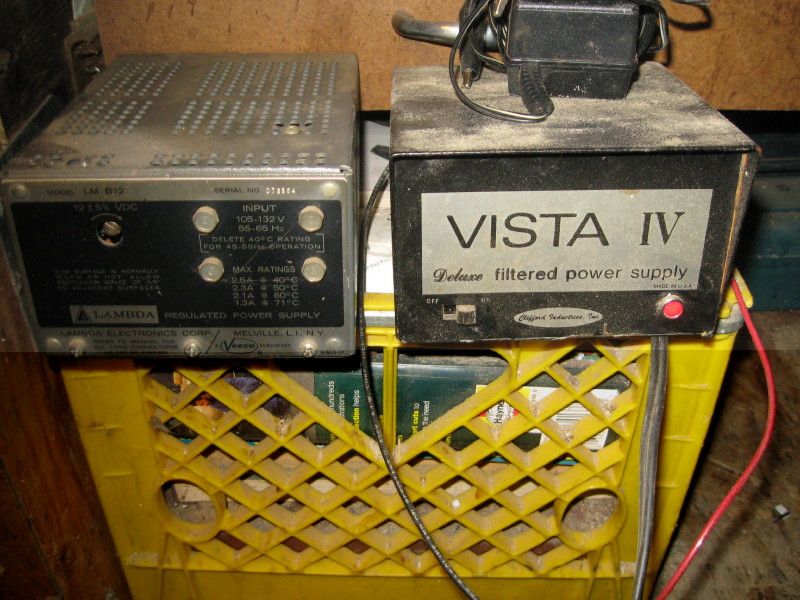Forum Discussion
westend
Feb 19, 2016Explorer
More excitement but on the "tender" side, am experimenting with power supplies I have on hand for battery storage.

The Vista is a regulated supply, 15.67V unloaded, 13,68 V on the battery, good for a semi-short term storage charge. I'll keep an eye on it for voltage rise over the next day.
The Lambda is also a good candidate, a regulated supply that's adjustable and should do tender duty well.
The wall wart on top is my go to tender for these auto batteries. It takes about 4 days for the voltage to rise to 14V and that is a good stopping point for me.
On a side note and trying to figure out the relationship between batteries and vehicle electronics, here's my story:
I have in the fleet, a 2003 Chevy Impala. It had a history of being unable to start. The battery was good and the starter worked but I narrowed down the cause to a faulty Body Control Module or the key switch which has sensors built on.
On recommendation, I spliced a resistor into the wiring to the BCM. This was to present a fixed voltage to the module, let it learn the level, and pass on a usable signal to the ECM, starter relay, and hence, start the car. It did work for a week and then, no starting.
I left the car parked and had my son in the car while I pushed it to it's Winter resting spot. What I didn't know is that he left the key on. It sat for three months with the key on draining the battery to nothing. Here comes the voodoo--After I charged the battery, for grins, I tried the ignition key-bam, started and ran like a champ.
The only thing I can think of is that the module had some capacitance that was drained over Winter and the lack of any power "cleaned it's slate", so to speak and allowed the BCM to learn the new voltage level.
If anyone has a clue to this, I'd sure like to learn. These GM early 2000 cars are plagued by electrical problems and am thinking about going back to imports.

The Vista is a regulated supply, 15.67V unloaded, 13,68 V on the battery, good for a semi-short term storage charge. I'll keep an eye on it for voltage rise over the next day.
The Lambda is also a good candidate, a regulated supply that's adjustable and should do tender duty well.
The wall wart on top is my go to tender for these auto batteries. It takes about 4 days for the voltage to rise to 14V and that is a good stopping point for me.
On a side note and trying to figure out the relationship between batteries and vehicle electronics, here's my story:
I have in the fleet, a 2003 Chevy Impala. It had a history of being unable to start. The battery was good and the starter worked but I narrowed down the cause to a faulty Body Control Module or the key switch which has sensors built on.
On recommendation, I spliced a resistor into the wiring to the BCM. This was to present a fixed voltage to the module, let it learn the level, and pass on a usable signal to the ECM, starter relay, and hence, start the car. It did work for a week and then, no starting.
I left the car parked and had my son in the car while I pushed it to it's Winter resting spot. What I didn't know is that he left the key on. It sat for three months with the key on draining the battery to nothing. Here comes the voodoo--After I charged the battery, for grins, I tried the ignition key-bam, started and ran like a champ.
The only thing I can think of is that the module had some capacitance that was drained over Winter and the lack of any power "cleaned it's slate", so to speak and allowed the BCM to learn the new voltage level.
If anyone has a clue to this, I'd sure like to learn. These GM early 2000 cars are plagued by electrical problems and am thinking about going back to imports.
About Technical Issues
Having RV issues? Connect with others who have been in your shoes.24,344 PostsLatest Activity: Dec 26, 2025